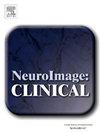纹状体-皮层连接模式预测亨廷顿氏病的临床特征
IF 3.6
2区 医学
Q2 NEUROIMAGING
引用次数: 0
摘要
背景:亨廷顿氏病是一种影响纹状体-皮层回路的遗传性神经退行性疾病,在症状的严重程度和进展以及神经退行性模式上具有显著的异质性。目的确定不同的功能性纹状体-皮层连接特征如何预测亨廷顿病的临床特征。方法对38例亨廷顿病基因扩增携带者进行横断面运动、认知和行为评估,并进行多模态MRI检查。主成分分析用于表征亨廷顿氏病的临床特征。接下来,基于种子的三种基底节核种子(尾状核、壳核、伏隔核)的全脑功能连接图被导出,以描绘皮质纹状体连接。多元线性回归评估了结果临床概况和基于种子的静息状态功能连接图之间的关系。最后,检查基底神经节灰质体积与临床特征和连通性的关系。结果主成分分析确定了亨廷顿病的两个主要临床特征:运动认知和行为。多元线性回归模型揭示了与每个剖面相关的不同功能神经特征。运动-认知症状与不同的连接模式有关,特别是尾状核和壳核与执行区和运动前区之间的连接减少,而腹侧伏隔核与执行网络区域之间的连接增加。与此同时,行为特征与边缘网络连通性下降有关。基底神经节萎缩与伏隔核-皮质连通性增加以及运动-认知症状严重程度有关。结论:不同的亨廷顿舞蹈病临床特征主要表现为运动-认知或行为障碍,每种障碍都与独特的功能和结构脑特征相关。这证实纹状体-皮层回路表现出功能性的相互作用和潜在的重组。本文章由计算机程序翻译,如有差异,请以英文原文为准。
Striato-cortical connectivity patterns predict clinical profiles in Huntington’s disease
Background
Huntington’s disease is an inherited neurodegenerative disorder affecting striato-cortical circuits, with significant heterogeneity in the severity and progression of symptoms and neurodegenerative patterns.
Objectives
To identify how distinct functional striato-cortical connectivity signatures may predict clinical profiles in Huntington’s disease.
Methods
Thirty-eight Huntington’s disease gene expansion carriers underwent cross-sectional motor, cognitive, and behavioral assessments and multimodal MRI. Principal component analysis was employed to characterize Huntington’s disease clinical profiles. Next, seed-based whole-brain functional connectivity maps were derived for three basal ganglia seeds (caudate nucleus, putamen, nucleus accumbens) to delineate cortico-striatal connections. Multiple linear regressions assessed relationships between resulting clinical profiles and seed-based resting-state functional connectivity maps. Finally, basal ganglia gray matter volumes were examined in relation to clinical profiles and connectivity.
Results
Principal component analysis identified two main clinical profiles in Huntington’s disease: motor-cognitive and behavioral. Multiple linear regression models revealed distinct functional neural signatures associated with each profile. Motor-cognitive symptoms related with a divergent connectivity pattern, specifically decreased connectivity between the caudate and putamen with executive and premotor areas, in contrast to increased connectivity between the ventral nucleus accumbens and executive network regions. Meanwhile, the behavioral profile was linked to decreased connectivity in limbic networks. Basal ganglia atrophy was associated with increased nucleus accumbens-cortical connectivity as well as motor-cognitive symptom severity.
Conclusions
Distinct Huntington’s disease clinical profiles can be characterized by predominantly motor-cognitive or behavioral disturbances, each related with unique functional and structural brain signatures. This substantiates that striato-cortical circuits exhibit functional interaction and potential reorganization.
求助全文
通过发布文献求助,成功后即可免费获取论文全文。
去求助
来源期刊

Neuroimage-Clinical
NEUROIMAGING-
CiteScore
7.50
自引率
4.80%
发文量
368
审稿时长
52 days
期刊介绍:
NeuroImage: Clinical, a journal of diseases, disorders and syndromes involving the Nervous System, provides a vehicle for communicating important advances in the study of abnormal structure-function relationships of the human nervous system based on imaging.
The focus of NeuroImage: Clinical is on defining changes to the brain associated with primary neurologic and psychiatric diseases and disorders of the nervous system as well as behavioral syndromes and developmental conditions. The main criterion for judging papers is the extent of scientific advancement in the understanding of the pathophysiologic mechanisms of diseases and disorders, in identification of functional models that link clinical signs and symptoms with brain function and in the creation of image based tools applicable to a broad range of clinical needs including diagnosis, monitoring and tracking of illness, predicting therapeutic response and development of new treatments. Papers dealing with structure and function in animal models will also be considered if they reveal mechanisms that can be readily translated to human conditions.
 求助内容:
求助内容: 应助结果提醒方式:
应助结果提醒方式:


